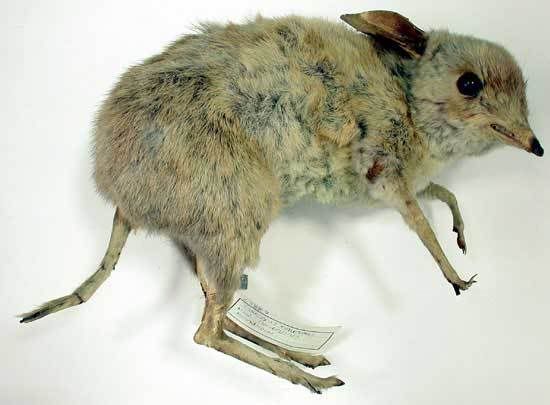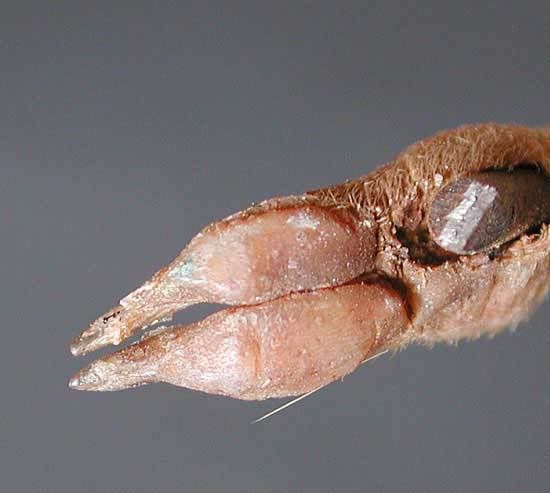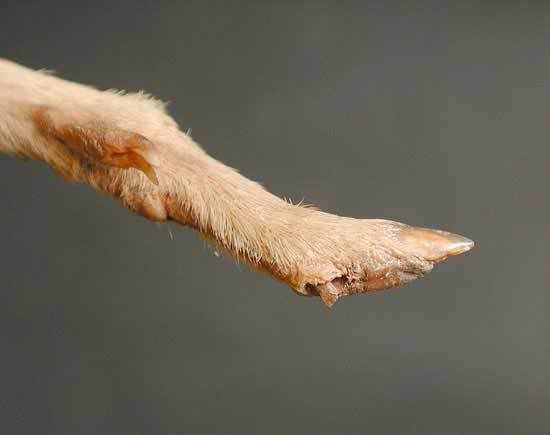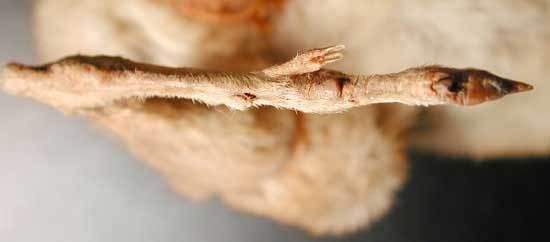|
|
Post by Melanie on May 21, 2005 20:23:35 GMT
The Pig-footed Bandicoot occurred in Australia. It was recorded from Western Australia, through South Australia and the southern part of the Northern Territory, to southwestern New South Wales and western Victoria. The last known specimen was collected from Lake Eyre, South Australia in 1907. Reports of sightings in central Australia during the 1920s were unconfirmed.
Habitat and Ecology Chaeropus ecaudatus was found in arid areas such as sclerophyll woodland, mallee, heath and grassland.
Threats The main causes of this species’ decline are thought to be through introduced predators (foxes and cats), overgrazing of habitat by domestic livestock, and competition from rabbits
|
|
|
|
Post by Melanie on May 21, 2005 21:18:01 GMT
Pic of museum specimen Adult Pig-footed Bandicoot Chaeropus ecaudatus  Specimen Reg. No. C 5887. This specimen was collected at Mondellimin (Victoria),16 km south of the junction of the Murray River & Darling River, during the Blandowski Expedition in 1857. Photo Ken Walker © Museum Victoria www.museum.vic.gov.au/ |
|
|
|
Post by another specialist on May 21, 2005 21:20:55 GMT
|
|
|
|
Post by another specialist on May 21, 2005 21:27:00 GMT
|
|
|
|
Post by another specialist on May 21, 2005 21:28:42 GMT
Pig-Footed Bandicoot The animal on the cover of Java NIO is a pig-footed bandicoot (Chaeropus ecaudatus). Though a specimen has not been uncovered since the early 20th century, pig-footed bandicoots were once found throughout central and south Australia and in Victoria. These rabbit-like creatures dwelled in many habitats. In the central deserts, they took up residence in sand dunes. In Victoria, they lived in grassy plains. In other areas, they preferred open woodland with shrubs and grass. Pig-footed bandicoots grew to be about 230-260 millimeters in length, with a tail of 100-150 millimeters. They had rough, orange-brown fur on the dorsal side of their bodies and a lighter color on their undersides. Their long tails ended in a black tuft. Their bodies were narrow and compact, and they had pointed heads with ears like a rabbit's. Their feet and legs, however, were much different from other bandicoot species'. Its forelegs and hindlegs were long and skinny, ending in strangely shaped feet with nails resembling a pig's hoof. On its hindfeet, the second and third toes were fused, and only the fourth was used in locomotion. Pig-footed bandicoots are believed to have been solitary animals. Depending on their environment, they may have built nests made of grass or dug short tunnels with a nest at the end. These bandicoots lived on the ground and used their keen sense of smell to find food. The most well-documented behavior of Chaeropus ecaudatus was its locomotion. Their movements were often erratic. A slow gait took the form of a bunny hop, while an intermediate gait was a lumbering quadrepedal run with the hind limbs moving alternately. However, Aborigines have reported that the pig-footed bandicoot, if pursued, could reach blazing speeds by breaking into a smooth, galloping sprint. Little is known about the reproductive cycle of C. ecaudatus, but from studying other bandicoots, it can be inferred that pig-footed bandicoots did not carry more than four young per littler. Females had a strong, sturdy pouch that opened on their backsides. Generally, bandicoots have a short gestation period, around 12 days from conception to birth. Each young weighs about 0.5 grams. When their time in the pouch has ended, baby bandicoots are left in the nest, and around 8-10 days later, they leave with their mother to forage or hunt. javanio.info/bandicoot.html |
|
|
|
Post by another specialist on May 21, 2005 21:32:11 GMT
more info here.... en.wikipedia.org/wiki/Pig-footed_BandicootThe Pig-footed Bandicoot (Chaeropus ecaudatus) was a small, mostly herbivorous bandicoot of the arid and semi-arid plains of inland Australia. About the size of a kitten, it looked rather like a bilby, having long, slender limbs, large, pointed ears, and a long tail. On closer examination, however, it became apparent that the Pig-footed Bandicoot was very unusual for a marsupial. The forefeet had two functional toes with hoof-like nails, rather similar to a pig or deer. The hind feet had an enlarged fourth toe with a heavy claw shaped like a tiny horses’ hoof, with the other toes being vestigial: only the fused second and third toes being useful, and that not for locomotion but for grooming. It was distributed through a wide range of habitat types: from grassy woodland and grassland plains through to spinifex country. Although listed by taxonomists within the family Peramelidae, its form is quite distinct from the true bandicoots and bilbies and if the species were not extinct it would probably have been placed in a separate family or subfamily by now. The first specimen was collected in 1836 by Major Mitchell in northern Victoria near the junction of the Murray and Murrumbidgee rivers. Few scientists had the opportunity to observe living Pig-footed Bandicoots, and the only existing account of its behaviour — suggesting that it moved 'like a broken-down hack in a canter, apparently dragging the hind quarters after it' — is contradicted by the reports of the Aboriginal people of central Australia, who knew it well and reported that it made nests out of grass to sleep in during the day and that, if disturbed, it was capable of running with considerable speed. It is thought to have taken shelter from predators in hollow logs and to have dug short, straight burrows with a nest at the end. A handful of specimens were collected through the second part of the 19th Century, mostly from north-western Victoria, but also from arid country in South Australia, Western Australia, and the Northern Territory. The last certain specimen was collected in 1901. Neveretheless, Aboriginal people report that it survived for another 20 years or so in South Australia, and as late as the 1950s in the most remote deserts of Western Australia. The species seems to have been moderately common before the arrival of Europeans on the continent, but it was in a serious decline even as it first came to scientific notice in the middle years of the 19th Century. By the start of the 20th Century it had become extinct in Victoria and the fertile part of Western Australia. The cause of the extinction remains uncertain: neither of the two most destructive introduced exterminator species, the fox and the rabbit, had arrived in south-west Western Australia when the Pig-footed Bandicoot disappeared from that area. Feral cats were already common, which may offer an explanation. It is perhaps more likely that the decline was caused by a double habitat change. First, the end of many thousands of years of Aboriginal burning which, being confined to a patchwork of small areas at any one time, ensured both fresh new growth in the recently burnt areas and adjacent older growth for shelter and as a base for recolonisation. (Australia's Aboriginal population declined by around 90% during the 19th century, largely because of the introduction of European diseases, and the remaining Aboriginies were often no longer permitted to carry on their traditional land-management and hunting practices.) Second, following on the heels of the near-extermination of the Aboriginal people, came the introduction of vast numbers of sheep and cattle, leading to significant changes in soil structure, plant growth, and food availability. From surviving eyewitness reports and analysis of gut contents, dentition, and gut structure of museum specimes, it appears that the Pig-footed Bandicoot was the most herbivorous of bandicoots: although captive specimens were fond of meat and Aborigines reported that it ate ants and termites, the bulk of the diet was almost certainly leaves, roots and grasses. bird.net.au/bird/index.php?title=Pig-footed_Bandicoot |
|
|
|
Post by another specialist on Jun 3, 2005 9:12:26 GMT
Pig-footed Bandicoot (Chaeropus ecaudatus) Distribution: Inland Australia. Last Record: 1901. The pig-footed bandicoot was one of the very strangest of marsupials. The size of a kitten, it had long, slender limbs, the hind feet bearing a single, elongated toe like a tiny horses’ hoof, while the forefeet bore two digits resembling miniature cloven hoofs. As its limbs suggest, it had a peculiar gait, being likened by one nineteenth-century naturalist as akin to ‘a broken-down hack in a canter, apparently dragging the hindquarters after it’. Pig-footed bandicoots were never common, although the species was rather widespread. They appear to have been principally vegetarian, taking grass seeds in the wild, although in captivity they ate lettuce, bulbs and grasshoppers, and according to one observer they drank a good deal of water. By day they sheltered in a grass nest, from which they emerged in the evening to feed. Twins may have been normal, with breed occurring between May and June. Gerard Krefft, who collected eight specimens near the junction of the Murray and Darling rivers in 1857, took a drawing of a specimen with him to show to Aborigines, to help explain that this was the animal he was anxious to procure. Unfortunately the only drawing he could obtain was of a specimen that had lost its tail, and his Aboriginal helpers brought him any number of common bandicoots with their tails screwed out, before finally arriving with two living pig-footed bandicoots. Krefft, who was on short rations at the time, studied them for some time before he was forced to kill them. He recorded that ‘they are very good eating, and I am sorry to say that my appetite more than once overruled my love for science; but 24 hours upon "pig face" (Mesembryanthemum) will damp the ardour of any naturalist.’ The Australian nation came into existence through federation in 1901, the same year that the last pig-footed bandicoot specimen was secured. Interviews with Aborigines living in remote regions, however, suggest that the species survived long after this, finally becoming extinct in the western desert as late as the 1950s. Just which factors, such as the introduction of foxes, cattle, sheep, cats or changed fire regime was responsible for the extinction of this strange creature remains unclear. rainforestinfo.org.au/spp/Schouten/pig.htm |
|
|
|
Post by another specialist on Jun 5, 2005 15:25:19 GMT
|
|
|
|
Post by sebbe67 on Aug 10, 2005 15:46:37 GMT
Eastern Pig-footed Bandicoot Chaeropus ecaudatus ecaudatus
Southeastern Australia, last recorded 1901. But suspected to have survived to 1954-1955
|
|
|
|
Post by another specialist on Aug 11, 2005 3:23:32 GMT
|
|
|
|
Post by another specialist on Aug 11, 2005 3:38:48 GMT
|
|
|
|
Post by another specialist on Nov 6, 2005 18:49:11 GMT
 gap in nature |
|
|
|
Post by another specialist on Nov 8, 2005 15:58:15 GMT
Pig-footed Bandicoot The Pig-footed Bandicoot is said to be the ‘most graceful and delicate’ of all the varieties of bandicoot. It is different from other kinds of bandicoot because it has only two toes on the front feet and one on the back feet. The Pig-footed Bandicoot fed mostly on grass, leaves and roots, but sometimes ate insects and meat, and was active at night when it fed on these. During the day it rested in nests made from dry grass in 30cm deep holes in the ground. The Bandicoot was able to burrow its way in and out of the hole without leaving an opening at the top. Orange-brown on top, the Pig-footed Bandicoot is fawn underneath. www.samuseum.sa.gov.au/orig/extinctions/stockjnl.htm |
|
|
|
Post by Bucardo on Nov 8, 2005 23:39:24 GMT
www.naturalis.nl/300pearls/Pig-footed Bandicoot Extinct at last The Pig-footed Bandicoot, Chaeropus ecaudatus ( Ogilby, 1838) is named after its forefoot, which has only two functional toes. The foot indeed reminds of a pig's trotter, although 'deer-footed bandicoot' might have been a more appropriate name for this small, slender-legged animal. The Pig-footed Bandicoot has been found in widely scattered localities in the semi-arid parts of southern and central Australia. Fossil evidence suggests that its range was larger in prehistorical times, but by the 19th century it was already rare. Despite the help of Aborigines, the German zoologist Ludwig Krefft could only obtain eight specimens during half a year of collecting in 1857.  Not resistant to change The cause of extinction is something of a mystery. The usual threats to the Australian fauna are habitat destruction by cattle and rabbits, and the introduction of feral cats and foxes. Although all of these causes may have affected the population, the species appears to have been in decline before settlers colonized its habitat. Pig-footed Bandicoot built a grass-lined nest in a pit in the soil, which they excavated themselves. The occupants emerged when the evening came. The species was vegetarian, though some insects were taken.  The last specimen The last Pig-footed Bandicoot was caught in 1907 on the south-western shore of Lake Eyre North. However, the species probably lingered on untill the 1950's. The museum collection The specimen in the National Museum of Natural History was caught in southern Australia in the 19th century. The exact locality and date of collection are unknown. -------------------------------------------------------------------------------- Dr. L.W. van den Hoek Ostende
|
|
|
|
Post by Meaghan on Apr 1, 2007 19:07:34 GMT
Pig-footed Bandicoot Rises From the Dead By David Grimm ScienceNOW Daily News 1 April 2007 A kitten-sized Australian marsupial thought to have gone extinct over a century ago appears to be alive and well. The pig-footed bandicoot was last spotted in 1901, but today researchers provided fresh evidence of its existence. "It's a miracle," says Jared Watson, a conservation biologist at the University of Brunswick in Melbourne. "I thought we'd seen the last of this 8-teated, posteriorly pouched creature." Known for its rabbity ears, thin legs, and hooflike nails, the pig-footed bandicoot (Chaeropus ecaudatus) was once widespread throughout inland Australia. Its name literally means "tailless pig-foot", a misnomer applied to a specimen that--unbeknownst to first describer--had lost its long, orange-brown tail in a taxidermic mishap. European encroachment in the latter half of the 19th century permanently altered the bandicoot's habitat, setting the creature on the path to extinction. Famed Australian naturalist Gerard Krefft is thought to have recovered two of the last specimens, but tired of subsisting on meager field rations, he ate them both. "I am sorry to say that my appetite overruled my love for science," Krefft wrote in his journal. Now, a medley of multimedia may make up for Krefft's hasty stomach. In today's issue of Nature Zoology: Australia and Surrounding Islands, a team led by biologist Peter Shadbolt of the University of Queenstown in New Zealand documents three dramatic pieces of evidence for the pig-footed bandicoot's continued existence. The first is a photo taken by an American tourist on a walkabout. Although her thumb obscures most of the shot, a toe with a tiny, hooflike nail can clearly be seen in the lower right-hand corner. Then there's the audio evidence: At the end of a track entitled "Get Off My (Out)Back" from Australian rock band AC/DC's most recent album, Rockin' the Wilderness, there is the faint sound of two squeals quickly followed by a high-pitched yowl. "The band recorded the album outdoors," Shadbolt explains. "They must have caught a pig-footed bandicoot mating call during one of their sessions." But the most convincing evidence, says Shadbolt, is a grainy video that showed up on YouTube in December. The clip, apparently intended to document the humiliation one man suffers after being hit in the groin by his own boomerang, catches a rabbit-sized creature fleeing with the pig-footed bandicoot's characteristic awkward gallop. "I snerked my Guinness when I saw the boomerang thwack the guy," Shadbolt says. "I almost missed the bandicoot footage." In total, the evidence is so persuasive, says conservationist Terry Shaw of Canada's National Wildlife Alliance, that Australian game officials should set up a perimeter around the center of the continent and begin searching for more bandicoots. Korean stem cell researcher Woo Suk Hwang has offered to clone the animal should any of its DNA be found. But not everyone is convinced. "I'd say the creature in that video is more young-cat-sized than kitten-sized," says marsupial expert Langston Buckwalter of St. Elizabeth College in Oxford, U.K. "And its gait is clumsy rather than awkward." But most troubling, says Buckwalter, is the fact that Shadbolt's team published a nearly identical study on this date last year. "Something about the first of April tends to bring the dodos out of the woodwork," he says. sciencenow.sciencemag.org/cgi/content/full/2007/401/1 |
|
|
|
Post by another specialist on Apr 1, 2007 21:25:08 GMT
Very interesting - Would love to see this video clip from you tube.
|
|
|
|
Post by another specialist on Sept 4, 2007 9:29:17 GMT
|
|
|
|
Post by another specialist on Sept 4, 2007 9:36:58 GMT
Front foot from below, of a Pig Footed Bandicoot Chaeropus ecaudatus  This specimen was collected by W.Blandowski in 1857 near the junction of the Murray River & Darling River. Photo by Simon Hinkley and Ken Walker © Museum Victoria Hind foot from side on, of a Pig Footed Bandicoot Chaeropus ecaudatus  Specimen Reg. No. C 5889. This specimen was collected by W.Blandowski in 1857 near the junction of the Murray River & Darling River. Photo by Simon Hinkley and Ken Walker © Museum Victoria Hind foot from below, of a Pig Footed Bandicoot Chaeropus ecaudatus  Specimen Reg. No. C 5889. This specimen was collected by W.Blandowski in 1857 near the junction of the Murray River & Darling River. Photo by Simon Hinkley and Ken Walker © Museum Victoria www.museum.vic.gov.au/ |
|
|
|
Post by another specialist on Sept 4, 2007 9:38:18 GMT
|
|
|
|
Post by another specialist on Sept 9, 2007 21:39:20 GMT
|
|